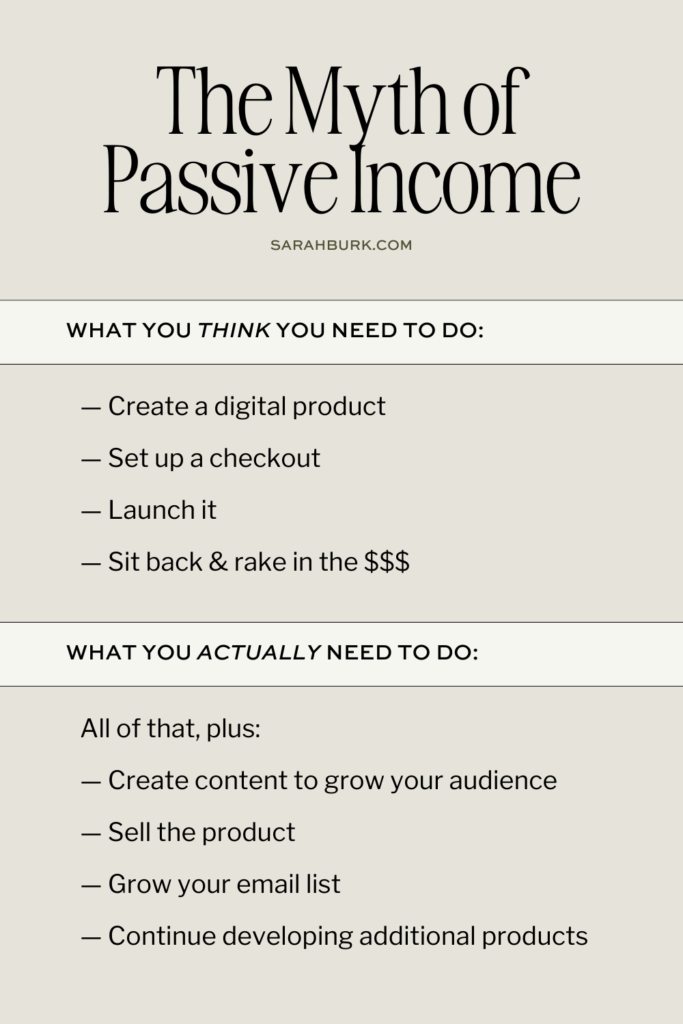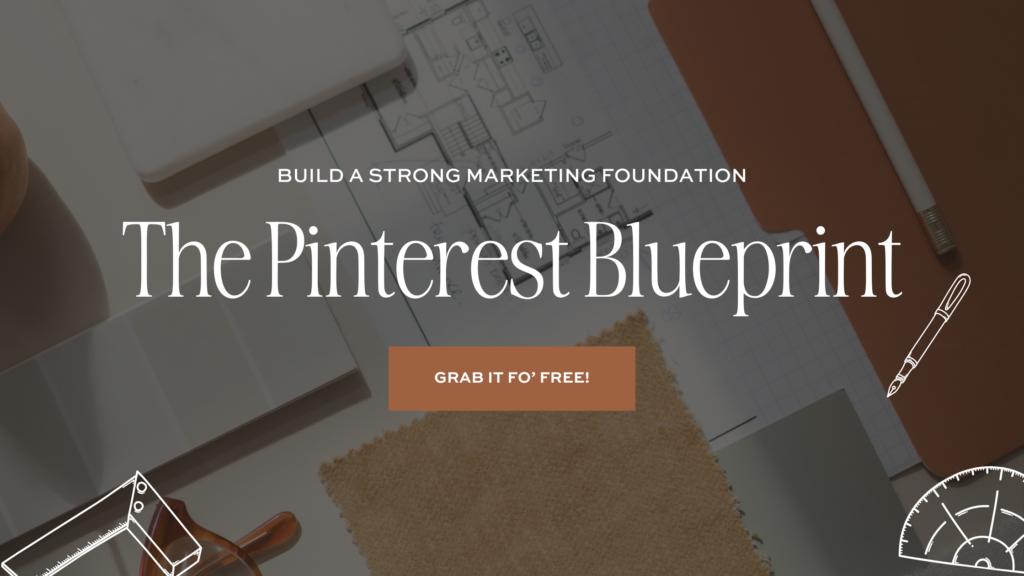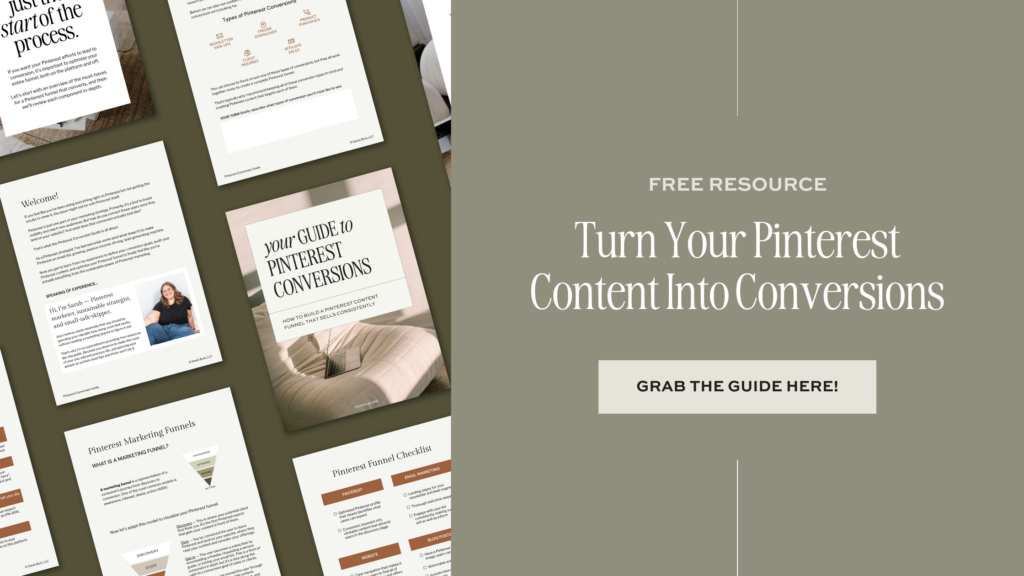“Passive income” is a popular buzzword, but is it truly possible on Pinterest?
Spoiler alert: passive income definitely isn’t what you think it is.
While it’s sold as the online business owner’s dream, the reality is much different. And if you’ve ever tried to make passive income on Pinterest yourself, you know it’s far from truly passive.
So if passive income is a myth, what’s the truth?
In short, Pinterest marketing can be a helpful tool to help you move toward more passive income streams, but it still requires proper strategy and intention to get it really working for you.
This is the realistic guide of how to make passive income on Pinterest for every creative entrepreneur tired of being sold a gilded girlboss dream.
The Passive Income Myth
There’s no legend more captivating, no reward more enticing than the concept of making money while doing nothing. We don’t want to admit it, but it’s true. Most of us spend a decent amount of brain power dreaming up ways to make more money while doing less work.
There’s no shame in it! The shame comes later, when we’ve followed all the roadmaps and done “all the right things” and still don’t have oodles of cash flowing in to retire our husbands or sip bellinis by the beach.
(BTW, I’m not aiming for either of those things.)
I don’t want to give passive income a completely bad reputation though. She’s not getting the villain edit in this reality show; she’s just the misunderstood girl who thinks the louder she is the more people will like her.
Well, Miss Passive Income (23, Puppy Pedicurist, San Diego), this is my tell-all confessional, and I’m going to show everyone your true colors…
What is Passive Income?
Passive income is a form of income that is typically earned by doing little or no work when the transaction occurs.
That second clause is usually pretty silent in most definitions of passive income, though. Because the thing with passive income as it’s marketed is that it’s a way to earn money while doing nothing. This dream scenario completely overlooks all the effort that goes into creating the product and marketing it.
But I’m getting ahead of myself…
Most passive income ideas involve some form of digital product or online course. In selling digital products, you don’t have to trade your time for money by providing a service, and you don’t have to deal with the manufacturing and shipping of physical products.
Why Passive Income Isn’t Truly Passive
You might not have to provide a service, stock inventory, or print out shipping labels, but creating a passive income stream requires much more work on the backend. And unlike selling services or physical products, you have to create the digital product first, before you even sell a single unit.
(Of course, this overlooks the concept of beta launching, market research, and other tactics you can use to reduce risk in developing digital products, but still!)
The idea that you can create a digital product and be wealthy overnight is one of the biggest myths about passive income.
Not only do you have all the upfront work of creating the product, setting up the tech, and hosting the product/course somewhere, you also have the ongoing work of marketing your digital products.
Unfortunately, this isn’t the Field of Dreams and “if you build it, they will come” doesn’t apply for creative entrepreneurs.

So, should you give up on your dream of passive income?
No! Not at all! I’ll be the first to validate that you should have multiple streams of income. As a service provider, having digital products or courses that your audience can purchase allows you to scale your income without overworking yourself — in theory.
The key to making the myth of passive income closer to reality is Pinterest.
How Pinterest Can Help You Make Money Passively
Now that we’ve cleared up the fact that passive income isn’t, in fact, 100% passive, let’s figure out what we can make more passive. And that is your marketing.
Whether you’re selling one course or dozens of low-ticket digital products, the only way you’re going to get sales is by actually selling. And I don’t know about you, but trying to balance building a personal brand, “providing value,” promoting my services, growing my email list, and equally marketing every single one of my digital products is a circus act I’m wholly uninterested in.
It’s just too much. There’s always something to market, and it can be utterly exhausting.
Here’s where Pinterest comes in. While it won’t make your entire business passive, it can certainly lighten the load. Pinterest is one of the best marketing strategies for business owners tapped on time due to its search engine capabilities, content longevity, and motivated users.
Pinterest as a Search Engine
Because Pinterest is a visual search engine, your content distribution isn’t determined by how many followers you have. As long as you follow Pinterest SEO best practices and use relevant Pinterest keywords in your content, your pins can be discovered by whoever might be looking for them!
Longevity of Pinterest Content
Another perk to how Pinterest works is the lifespan of your content. On Pinterest, your content lives much longer than a 24-hour Instagram story. Pins can drive traffic to your digital products for months or even years!
Between the search-driven Pinterest algorithm and the long content lifespan on the platform, users can discover your pins at any point in time. That means you don’t constantly have to be putting out new content for your digital products, hoping to catch a buyer at the right stage of awareness. On Pinterest, your content and products are there just waiting to be discovered whenever a user is ready to take action.
Pinterest Users are More Motivated Spenders
Speaking of taking action, Pinterest users as a whole tend to be more motivated to make a purchase and often spend more than users referred from other platforms.
Put this together with Pinterest’s search engine capabilities and you get individuals opening Pinterest with a specific need in mind, finding your product, and (hopefully) purchasing it! All without having to set up a Manychat automation or push people towards your “link in bio”.
Creating Passive Sales on Pinterest
While the actual work of Pinterest marketing isn’t passive, it offers a more sustainable way to market your digital products consistently.
Once you’ve created strategic, keyword-optimized content, that content can continue to work for you, driving traffic and potential sales over time. It’s a whole lot more passive than selling on stories every day, if you ask me.
Key Components to Generating Passive Income from Pinterest
There are two crucial elements when it comes to making passive income from Pinterest: the Pinterest marketing itself and your sales funnel.
Pinterest Marketing Strategy for Passive Income
The foundation of any successful Pinterest marketing strategy is build on solid keyword research and an optimized Pinterest business account.
By using the right keywords, you ensure your content is discoverable by people actively searching for solutions that your digital products provide. This is the backbone of Pinterest SEO and the key to building a Pinterest sales funnel that drives long-term traffic.
To help you lay this solid foundation, I created a free Pinterest Blueprint that walks you through every step of setting up your account for success, from choosing the right keywords to optimizing your profile.
Download the Pinterest Blueprint here to get started!
Once you’ve nailed the basics, the next step is consistently creating and publishing a variety of pins. These pins should link back to your content, which may include:
- Free educational content like blog posts or guides to build trust
- Lead magnets that capture your audience’s email, continue providing free value, and move them further through your funnel
- Product pages for direct purchases.
Pinterest serves as the top of your sales funnel, driving visibility and traffic to the content that starts your nurturing process.
Pinterest as the Top of the Funnel
The way sales funnels work is by having lots of people enter the top of the funnel, with fewer and fewer moving to each next part of the funnel. By that definition, it’s essential that you have lots of people entering your funnel at the beginning, which is precisely what Pinterest is so good at.
Pinterest is a highly effective traffic driver and one that’s unique in its capability to drive traffic long-term. Users searching on Pinterest are able to find your content at any point in time, allowing you to set up an automated sales funnel for your digital products without constantly needing to create new content.
Creating a Passive Sales Funnel
Once you have Pinterest driving traffic consistently, it’s crucial to have a sales funnel that captures, nurtures, and converts that traffic into paying customers. Here’s how it works
- Capture: Use lead magnets to offer something of value in exchange for email addresses.
- You can direct Pinterest traffic to blog posts with calls to action to lead magnets and to the lead magnet landing pages themselves
- Getting people on your email list through a lead magnet is going to be what helps you continue to nurture and sell to them in a more personalized manner
- Nurture: Once an individual is in your funnel, an email sequence should nurture them by building trust and providing additional value
- This could include more helpful content, case studies, testimonials, insights into your digital products, or special offers for subscribers
- You can see a sample lead magnet welcome sequence here!
- Convert: The final step in the funnel is the conversion — the purchase!
- Whether it’s through digital products, courses, or another evergreen sales offer, your Pinterest sales funnel should be set up to naturally drive Pinterest traffic toward making a purchase
If you want to ensure your sales funnel is optimized to convert all that Pinterest traffic, grab my free Pinterest Conversion Guide! In it, you’ll find actionable tips and checklists to give you a crash course in conversion-friendly content strategy.
Get your guide here and start optimizing your funnel today!
Make Pinterest Work for Your Business — Passively
So, can you really make passive income from Pinterest? Sort of! As long as we acknowledge that the concept of passive income isn’t entirely passive, Pinterest can help you sell your offers passively, as long as you have the right strategy backing it up.
If you want to use Pinterest for passive income, here’s what you should focus on:
- Optimize for Pinterest SEO: Ensure that your pins and boards are keyword-rich and aligned with what your target audience is searching for.
- Pin consistently: Regularly publish high-quality pins that direct traffic to valuable content, lead magnets, and products.
- Set up a conversion-optimized Pinterest funnel: Create a sales funnel that captures, nurtures, and converts your Pinterest traffic into loyal customers, making sure to optimize every part of the funnel for your Pinterest audience.
By implementing these strategies, you can simplify your marketing, diversify your income sources, and free up time to work on other priorities in your life and business.
Ready to take the next step? Here are some additional resources you might be interested in:
>> Book a Pinterest audit. My personalized Pinterest audit service evaluates your current Pinterest marketing and sales funnel, giving you a custom Pinterest strategy and plan to achieve all your passive income goals!
>> Download the FREE Pinterest Conversion Guide. This guide offers invaluable insights into building a Pinterest content funnel that sells consistently, including a multitude of resources to support you along the way!
>> Purchase the Pinterest Keyword Bank for Digital Products. This Newsstand best-seller provides a curated database of Pinterest keywords tailored to digital products and any business owner in the online space, helping you drive more targeted traffic to your offerings!


